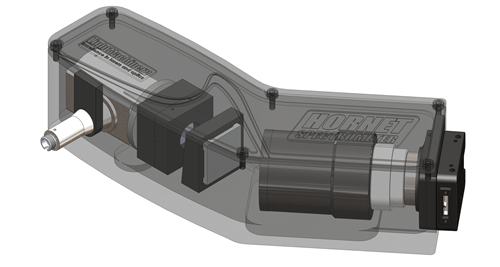The Hornet series of spectrometers have been developed based on LightMachinery's patented Fluid Jet Polishing technology. Designed for characterizing laser spectra, LightMachinery’s Hornet spectrometer is a compact, cost-effective spectrometer capable of better than 30 picometer resolution. This spectrometer is capable of attaining the resolution of large gratings spectrometers at a fraction of their cost and size while covering a huge wavelength range. The spectrometer’s simple PC based software allows the user to review spectra in real-time and export or save for further analysis. Labview drivers allow the Hornet spectrometer to be incorporated into automated experimental setups.
Features
The key features of the Hornet spectrometer are as follows:
- Simple to use
- Fiber optic input
- Sub 30 pm picometer resolution
- Quick data acquisition and export
- LabView Drivers
- Simple USB interface
- No moving parts (single-shot laser spectrum analysis)
Benefits
The main benefits of the Hornet spectrometer include:
- Fast
- Low cost
- Ultra-compact
- Range - resolution ratio up to 10,000
- Can measure spectra from cw and pulsed sources
- Ultra-reliable
- Fast real-time measurements
- LightMachinery's legendary customer support
Specifications
The specifications of the Hornet spectrometer are as follows:
- Resolution: sub 20 pm at 532 nm (resolving power > 25,000)
- Dynamic range: >10^8 for the system, 1000 in a single measurement
- Accuracy: < 20 pm following calibration
- Simultaneous range/resolution: >10,000 at 532 nm
- Acquisition and processing speed: >2 Hz typical
- Calibration: a narrow band (<10 pm) external reference source is needed
- Wavelength range: Visible to near IR (450 nm to 1000 nm), factory setup from 50 nm to 300 nm width based on customer's requirements
| Part Number |
Spectral Region |
Wavelength Range |
Resolution |
| HN-9332 |
Visible |
400 nm - 700 nm |
30 pm |
| HN-9333 |
Visible |
400 nm - 450 nm |
13 pm |
| HN-9334 |
Visible |
450 nm - 500 nm |
15 pm |
| HN-9335 |
Visible |
500 nm - 550 nm |
16 pm |
| HN-9336 |
Visible |
550 nm - 600 nm |
18 pm |
| HN-9337 |
Visible |
600 nm - 650 nm |
20 pm |
| HN-9338 |
Visible |
650 nm - 700 nm |
22 pm |
| HN-9340 |
UV |
260 nm - 300 nm |
15 pm |
| HN-9350 |
IR |
1025 nm - 1075 nm |
19 pm |
| HN-9351 |
IR |
1550 nm - 1600 nm |
21 pm |
Applications
The Hornet spectrometer is ideal for;
- Light source characterization
- Diode lasers
- Lasers
- Superluminescent diodes
- Monitoring laser modes in real-time
- Passive components (Etalons, Filters, Fiber Bragg gratings) characterization to the 25 pm level
- Checking the spectral/mode purity of lasers
- High-resolution Raman spectroscopy
Drawing

How Does it Work?

Light enters the Hornet via a fiber. The beam is focused through a LightMachinery fluid jet polished etalon in order to produce extremely high dispersion in the vertical axis with sub 30 pm resolution. This is followed by a grating to cross disperse overlapping orders in the horizontal direction to develop a 2D spectrum of the input light, and the resulting pattern is then imaged onto the CCD detector. Finally, the spectrum is unwrapped by LightMachinery software to produce an ultra-high-resolution spectrum of the input light.